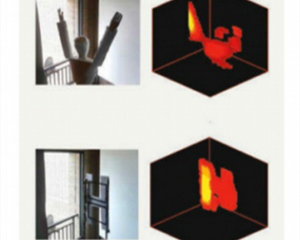Espionage (2)
間諜活動(2)
Round the bend
視線轉彎
How to see what is hidden from view
如何看見視線外的隱藏物
In a locked room in a busy city, some terrorists are holding a hostage. The curtains are mostly drawn, cutting off any direct line of sight for those outside. In a building across the street, a team of engineers are set a task: they can have whatever equipment they need, but they must paint as clear a picture as possible of what is happening inside the room.
在一個繁忙的城市中的一間上了鎖的房間里,一幫恐怖分子劫持了一名人質。窗簾被拉上了一大半,從外面無法直視其中。在街對面的一棟樓里,一隊工程師接到了一項任務:他們可以拿到任何他們需要的設備,但必須盡可能清晰地描繪出房間內正在發生的事情。
This was the challenge given in 2015 to Daniele Faccio, then at Heriot-Watt University, in Edinburgh, by Dstl, a British government defence laboratory. He and his team eventually found a way to see around corners from a distance of 50 metres— which was reckoned impressive at the time, even though the system they devised could detect only the motion and position of hidden objects, rather than taking pictures of them. Now, however, Xu Feihu and Pan Jianwei of the University of Science and Technology of China, in Hefei, have blown that record out of the water. As they describe in the Proceedings of the National Academy of Sciences, they have managed to look around corners from a distance of well over a kilometre.
這是2015年英國政府的國防科技實驗室Dstl給丹尼爾法喬(Daniele Faccio)的任務。當時供職于愛丁堡的赫瑞瓦特大學(Heriot-Watt-University)的法喬和他的團隊最后找到了從50米開外隔墻觀物的方法—這在當時被認為非常了不起,盡管他們設計的系統只能檢測到隱藏物體的動作和位置而無法給它們拍照。然而現在,位于合肥的中國科學技術大學的徐飛虎和潘建偉已徹底擊敗了這項紀錄。正如他們在《美國國家科學院院刊》中描述的那樣,他們已經能夠從一公里多外進行隔墻透視。

Non-line-of-sight imaging of this sort relies on two principles. One is that objects are visible to an observer if light bouncing off them makes its way to that observer's eyes or instruments. The other is that at least some light reflects off all but the blackest, most absorbing surfaces. The upshot is that something hidden from an observer's line of sight might nevertheless be visible if it is sufficiently near a wall which can serve as a reflecting surface. In this case, the observer can illuminate the wall with a tightly focused beam of light (in practice, probably a laser), knowing that some of the beam's light will bounce off the wall to illuminate the concealed object, and that some of this illumination will, in turn, be reflected back whence it came via the wall. The fraction of the original beam returned by this trilogy of reflections may be minuscule, and the information it contains may appear hopelessly jumbled. But sufficiently smart mathematics can turn it into an image of the thing it bounced off.
這種非視域成像技術(non-line-of-sight imaging)依賴兩個原理。一是如果從物體上反射的光線進入觀察者眼中或被儀器捕捉到,那么該物體便對觀察者可見。二是除了最黑暗、吸收力最強的表面外,至少有部分光會反射出去。其結果是,隱藏在觀察者視線之外的某物如果足夠靠近可作為反射面的墻體,那它還是有可能被看見。在這種情況下,觀察者可以用高度聚焦的光束(在現實中很可能是用激光)照亮這面墻,墻面會反射部分光束而照亮隱藏的物體,從該物體上又會反射一部分光通過墻面原路返回。經過這三重漫反射后,原始光束只返回了一小部分,可能非常微弱,所包含的信息也可能顯得極度混亂。但只要經過足夠智能的運算,就能將它變成該物體的成像。
譯文由可可原創,僅供學習交流使用,未經許可請勿轉載。











